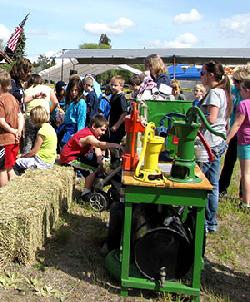 |
| Submitted photo |
Kids tour many outdoor museum displays during the warmer months, including this interactive display where people can operate pitcher pumps. Kids can pump water and learn what it was like before indoor plumbing, said Jayne Singleton, director of the Spokane Valley Heritage Museum.
|
|
|
|
|
In the February Wave: You had to do what?!?
1/28/2015 1:26:27 PM
Museum shows kids how life used to be
By Josh Johnson
Splash Staff Writer
Have you ever called your grandma using Facetime or Skype? Or how about something as simple as getting a glass of water from a dispenser on your fridge or going tubing behind a motorboat?
Did you know that 100 years ago, if a boy or girl your age saw you doing any of those things, they wouldn't be able to believe their eyes?
Making a phone call, getting a glass of water or even crossing a lake or river worked very differently not that long ago.
While no one could see 100 years into the future from 1915, you can find out how a lot of things worked in the past. You might just have the same reaction: You won't be able to believe your eyes!
The Spokane Valley Heritage Museum is a nearby place that has displays to show you how people used to live many years ago. The building they are located in is actually over 100 years old itself!
The Current talked to Museum Director Jayne Singleton about things she likes to show kids to illustrate how being a boy or girl in Spokane Valley used to be much different. Here are four of her favorites.
1. Talking on the phone
The first phone call was made from Alexander Graham Bell to his colleague, Thomas Watson, on March 10, 1876. It was not made with an iPhone 6 Plus!
His idea was that the sound of people's voices could be turned into an electrical signal down a wire of any length and then turn back into a sound someone else could hear on the other end.
At the Spokane Valley Museum, they have several examples of how older phones worked, including an actual switchboard that would be run by a human being - an operator. If you wanted to you're your grandmother, the switchboard operator would literally take your phone line and plug it into your grandma's phone line so that you could hear each other.
You can use the switchboard or make a call on a rotary phone and see how it works at the museum.
2. Crossing the lake or river
In our community, the Spokane River separates it north from south. Suppose you wanted to cross this river 200 years ago.
There were no bridges, so a man named Antoine Plante started a service to take people and their supplies across the river on a special boat called a ferry. Plante's Ferry Park is named after him, and it's where his ferry service was located.
Even before Plante ferried people across the river, the local Indians would use canoes to travel on the man local rivers and lakes.
The museum is home to a canoe like this that was made by the Nez Perce Tribe. Called a "dugout canoe," it was made by burning out the center of a large log. Stone tools were then used to further shape the canoe so there was a place for people to sit.
3. Getting a drink of water
During the summer, the museum opens up an outdoor area behind it that includes water pumps. Remember that glass of water we talked about? There were no sinks in houses or showers that just provided water by turning a knob.
If you needed a drink, or water for cooking, cleaning or bathing, you would go outside and use a pump.
This sort of thing wasn't exactly convenient in the middle of winter. Brrrr!
4. Going to the bathroom
Speaking of not convenient in the middle of winter, imagine if your bathroom wasn't down the hall.
Instead, what if it was down the hall
and through the living room
and out the back door
and across the yard
and located in a small wooden shed that didn't have any heat or air conditioning.
"This was the toilet, even into the early 1900s in the Valley," Singleton said.
The museum has an outhouse to show kids what it was like - but fortunately it's not there for people to use.
"It's a one-holer with a dummy sitting on it," Singleton said.
To learn more about how life used to be in Spokane Valley, visit the museum with your parents at 12114 E. Sprague Ave. You can find out more by calling 922-4570 (don't worry, cell phones will work) or using that fancy thing called the internet at www.valleyheritagecenter.org.
Advertisement

|
